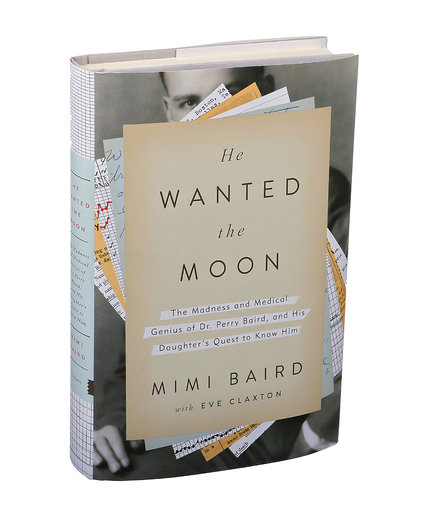Tags
"An Unquiet Mind", "Darkness Visible", "He Wanted the Moon", bipolar disease, Dr. Abigail Zuger, Dr. Perry Baird, Eve Claxton, Kay Redfield Jamison, Mimi Baird, NYTimes, William Styron

He Wanted the Moon: The Madness and Medical Genius of Dr. Perry Baird, and His Daughter’s Quest to Know Him. By Mimi Baird, with Eve Claxton. Crown. 272 pages.
The book is autobiography, biography, science, history and literature all in one, as instructive as any textbook and utterly impossible to put down.
from NYTimes review by Abigail Zuger, M.D.
If you’ve read William Styron’s small masterpiece Darkness Visible, you’ve ‘heard’ from a wonderful writer what “madness” is and what it feels like.
If you’ve read Kay Redfield Jamison’s An Unquiet Mind, you know, from both a personal and a scientific perspective, what it is to experience bipolar disease today (manic depression).
Now comes a just released book, He Wanted the Moon, to add to those two wonderful insights into what it is like to experience mental illness. Or in the case of this book, what it was like to experience bipolar disease before we understood it or had any treatment for it.
This one has many of the strengths of the two previous books, and more. I indeed agree with the review quoted above that it is “autobiography, biography, science, history and literature all in one, as instructive as any textbook and utterly impossible to put down.” And, I would add, it is told in such a manner that you haven’t read anything quite like it before.
At least I haven’t.
I will only mention a very simple outline of what you have before you as I believe you should experience it yourself and not through my or anyone else’s eyes.
Briefly, in 1944 a Harvard-trained physician wrote a memoir covering five months in his life in which he experienced (one of many) severe manic phases in which he was repeatedly hospitalized. That part of He Wanted the Moon has similarities to Styron and Jamison’s personal accounts of descent into madness.
This memoir, this manuscript, only came to light 30 years later when his daughter had begun to search for the story of her father’s life. She transcribed her father’s penciled manuscript, and that serves as one core of the book.
She was also able to get the records from her father’s hospitalizations as well as gather information from neighbors, (his) colleagues, and family. She then interweaves the hospital records and that other information into and around her father’s manuscript, thus giving the reader additional perspectives of what occurred with her father.
But those are only two parts of this gripping book. In her search to know her father, she discovers the details of his life before he had his first bipolar episode at the age of 29, what happened to him after the five months he records, and what ultimately happened to him. Be prepared for a number of surprises.
And it is her story also — the story of a child who lost her father at the age of five and then, at the age of 50, undertakes a 20-year journey to ‘know’ him and to write his (and her) story.
Finally, or additionally, because of the memoir, the accompanying records, and the details of what happened to this man, we learn that even though bipolar disease today can be a curse and a life long struggle for those enduring the disease, it is nothing like what individuals experienced before there was a true understanding of its cause and treatment. And, ironically, this individual, who suffered enormously from it, was on the trail to “unlock the key to treatment for it.”


romana campos said:
Great review. Sounds like a read that is both engrossing and educational. I’ll definitely add it to my reading list.
Thanks for sharing!
Romana